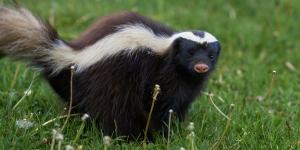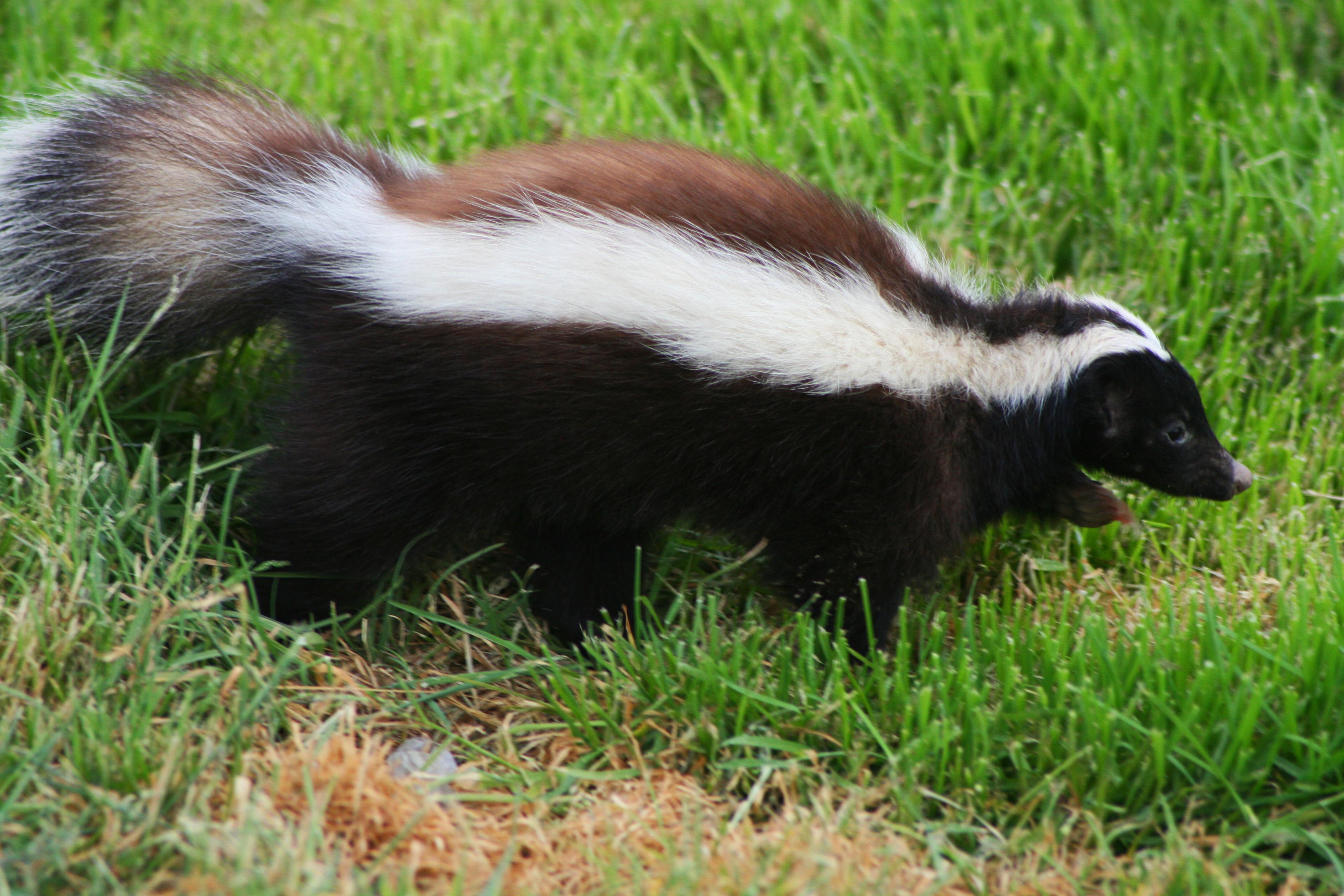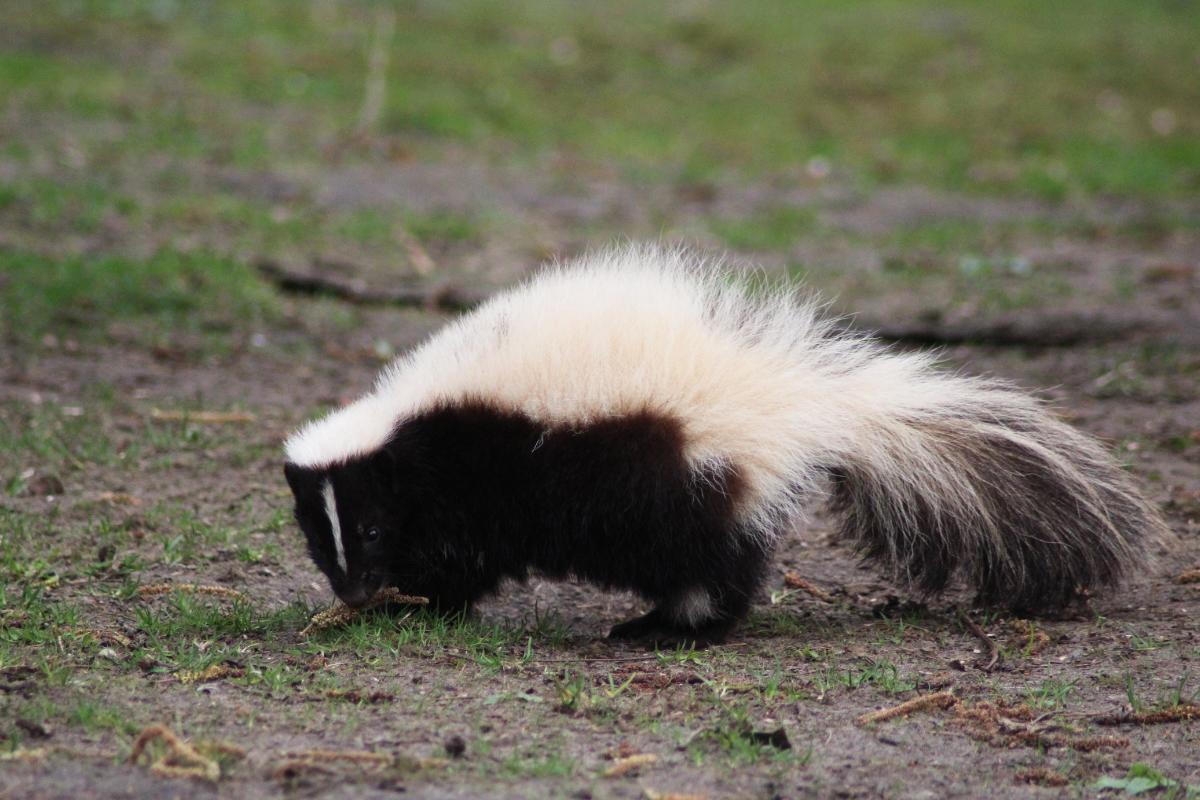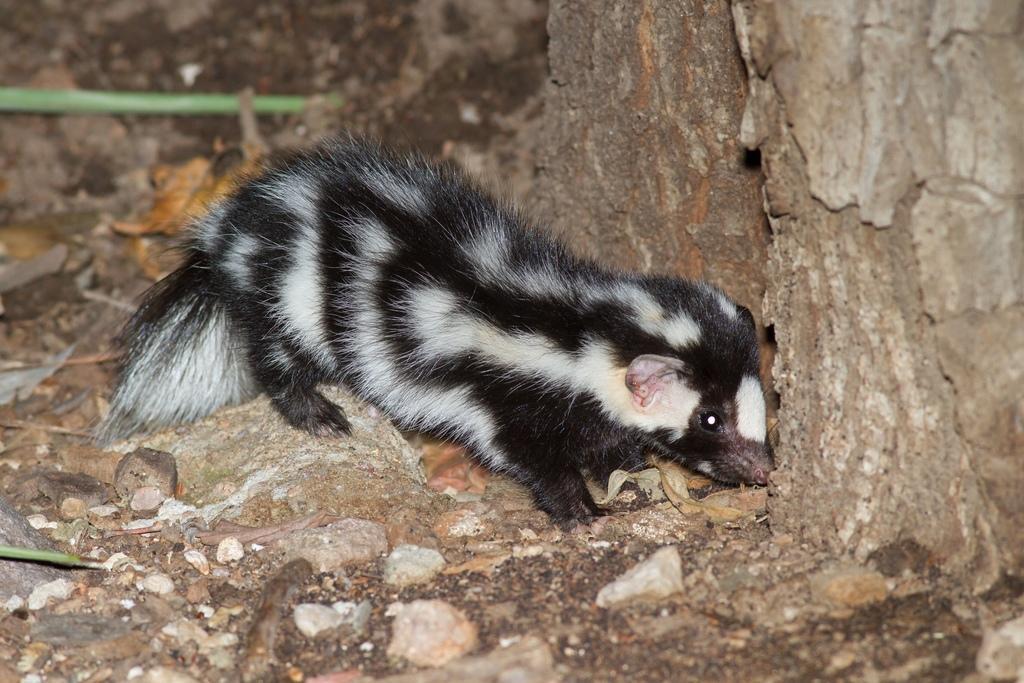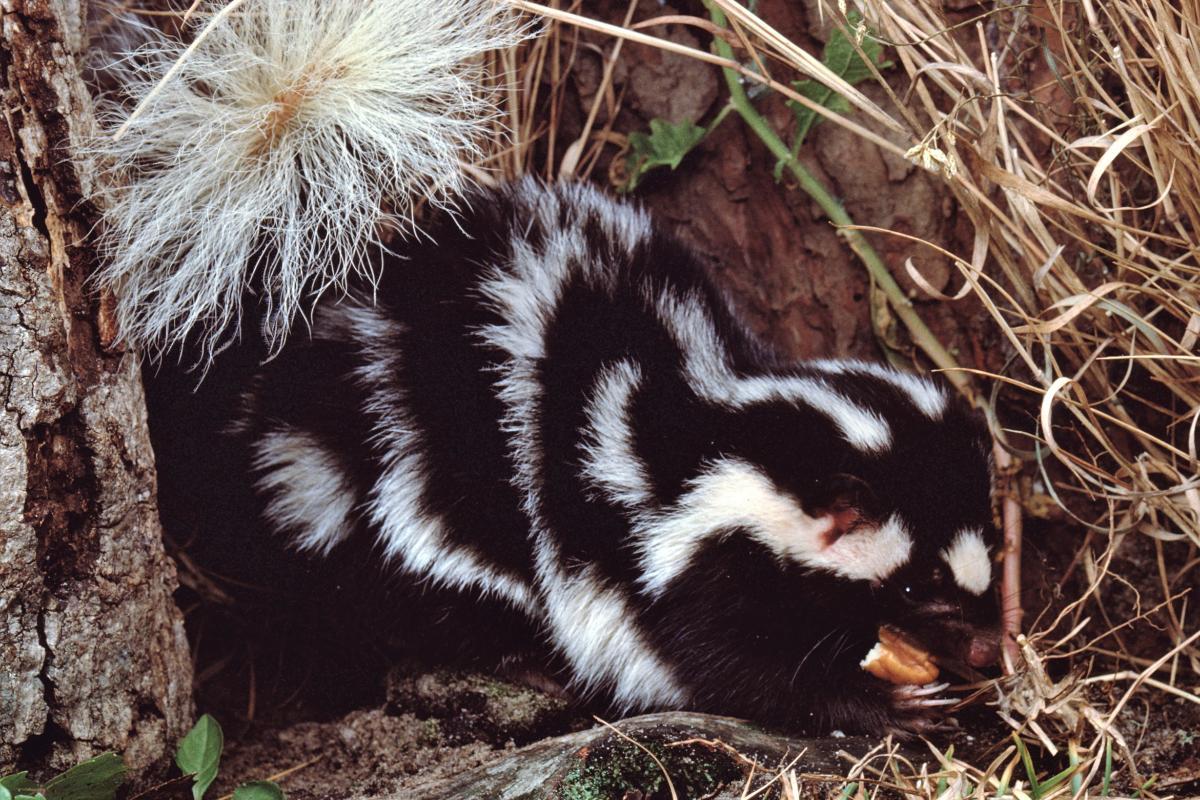Different Types of Skunks


Skunks are a type of mammal which make up the family Mephitidae, a more diverse taxonomic category than many of us might believe. This diversity has changed over time since similar mammals have been excluded or included over the years. Currently, the International Union for Conservation of Nature (IUCN) which classifies the group into four genera and 12 species. The individual species of these different skunk types have certain characteristics which distinguish them, but they also share common traits. These include patterned markings on their fur, a solitary nature and, perhaps their most distinguishable trait, scent glands which can be used to spray a defensive musk.
At AnimalWised, we look at all 12 different types of skunks. We provide information on their individual characteristics and behaviors, as well as photos of what each looks like.
- Molina's hog-nosed skunk (Conepatus chinga)
- Humboldt hog-nosed skunk (Conepatus humboldtii)
- American hog-nosed skunk (Conepatus leuconotus)
- Striped hog-nosed skunk (Conepatus semistriatus)
- Southern spotted skunk (Spilogale angustifrons)
- Striped skunk (Mephitis mephitis)
- Sunda stink badger (Mydaus javanensis)
- Pygmy spotted skunk (Spilogale pygmaea)
- Western spotted skunk (Spilogale gracilis)
- Hooded skunk (Mephitis macroura)
- Palawan stink badger (Mydaus marchei)
- Eastern spotted skunk (Spilogale putorius)
Molina's hog-nosed skunk (Conepatus chinga)
Also known as the Andes skunk, it should be no surprise the Molina's hog-nosed skunk (Conepatus chinga) is native to South America. Its population is distributed throughout Argentina, Bolivia, Brazil, Chile, Paraguay, Peru and Uruguay. It develops in areas of tall bushes and grasslands where it makes its burrows. There are studies that evaluate whether this species is conspecific with C. humboldtii, but for the moment they remain distinct.
This type of skunk weighs between 5-9.9 lb (2.3-4.5 kg) and is 18-35" (46-90 cm) long. Its fur is mainly black, but there are two white stripes that run from the head to the sides of the body. Their flat and fleshy nose provides their common name. As with all skunks, their scent glands produce a foul smelling liquid that repels predators. They are also resistant to snake venom, providing further protection. They are omnivorous, nocturnal and have a conservation status of ‘Least Concern’.

Humboldt hog-nosed skunk (Conepatus humboldtii)
As with all members of the genus Conepatus, our next type of skunk species is also a hog-nosed skunk. The Humboldt hog-nosed skunk (Conepatus humboldtii) is so similar to the Andes skunk that some experts claim they are the same. However, they are currently considered two distinct species.
This skunk is native to Argentina and Chile, living in grasslands, bush areas, rocky outcrops and close to urban spaces. The size can be between 4-23.6" (50-60 cm), with a weight between 3.9-15.9 oz (110-450 g). It has a long tail with black fur on their body which can have one or two white stripes on the sides, as seen in the photo. The trunk area is devoid of hair and there is no white color in this part of the body. Although omnivorous, it consumes mainly insects. It conservation status is ‘Least Concern’.
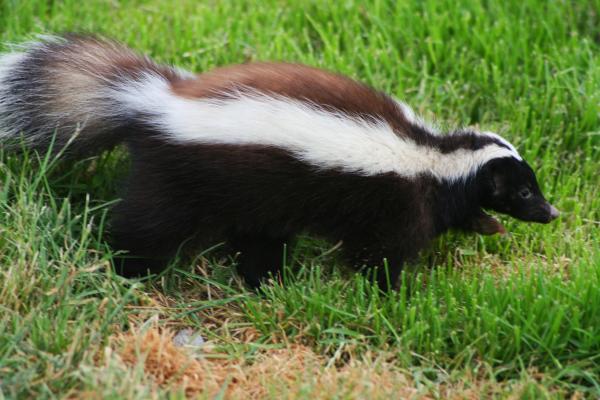
American hog-nosed skunk (Conepatus leuconotus)
Also native to the Americas, the American hog-nosed skunk (Conepatus leuconotus) has population distributions further north in Central America. Specifically, it can be found in El Salvador, Guatemala, Honduras, Mexico, Nicaragua and the United States. The species C. mesoleucus was previously considered distinct, but studies revealed that it is actually the same species as C. leuconotus. Several subspecies were also grouped as C. leuconotus leuconotus, as well as C. leuconotus figginsi and C. leuconotus telmales.
This type of skunk lives in forests, deserts, scrublands, and rocky canyons. It weighs between 2.2-9.9 lb (1-4.5 kg) with a length of 21.3-22.4" (54-57 cm), with the males being larger than females. It has a single white stripe that runs from head to tail. The rest of the fur is black, although some individuals can be a mostly white skunk, depending on the thickness of the stripe. The photo shows a thick kind. It has a large snout similar to that of a pig and is sometimes known as a rooter skunk because it roots around to search for food. It is of ‘Least Concern’.

Striped hog-nosed skunk (Conepatus semistriatus)
Rounding out the group of hog-nosed skunks is the striped hog-nosed skunk (Conepatus semistriatus), this time native to Belize, Brazil, Colombia, Costa Rica, Ecuador, Honduras, Mexico, Nicaragua, Panama, Peru and Venezuela. It lives in grasslands, open forests, deciduous forests and moderately disturbed areas, being very good at adapting to almost any habitat.
Its average weight is 3.5 lb (1.6 kg), while its length is 22.4" (57 cm). It has the typical black color, with a stripe that comes out from the nape of the neck and branches in two towards the back at the beginning of the tail. The stripe first turns black and then white. It is also nocturnal and omnivorous, but mainly consumes insects, birds and lizards. It is also in the ‘Least Concern’ category.

Southern spotted skunk (Spilogale angustifrons)
We now move on from hog-nosed skunks to the Spilogale genus which contains different types of skunk known as spotted skunks. While it was long thought to be a subspecies of another within the genus, the southern spotted skunk (Spilogale angustifrons) is currently considered a species of its own.
The southern spotted skunk lives in bushes, open forests and near agricultural spaces in Belize, Costa Rica, El Salvador, Guatemala, Honduras, Mexico and Nicaragua.It measures about 13.4" (34 cm), with a tail of approximately 9.1" (23 cm), and weighs between 1.1-2.2 lb (0.51 kg). The base color is black, with several white stripes on the back , while the underside is black. Although it is terrestrial, it climbs very well. It is also considered of ‘Least Concern’.

Striped skunk (Mephitis mephitis)
The striped skunk (Mephitis mephitis) is native to Canada, Mexico and the United States. Some records consider there to be 12 further subspecies. It lives in plains, deserts, forest edges, agricultural areas, swampy and urban spaces.
The coat of the striped skunk is black, with a thin stripe from the muzzle to the forehead. The pattern varies, but generally there is also a white line from the nape that goes down and divides into two along the body. It usually has white hairs on its tail. It weighs from about 2.2 to 13.2 lb (1 to 6 kg) and the length is 15.7"-31.5" (40-80 cm). This is one of the most famous skunk species, being the basis for the well-known Warner Bros. cartoon character Pepé Le Pew.

Sunda stink badger (Mydaus javanensis)
Despite their common name, the Sunda stink badger (Mydaus javanensis) is actually a type of skunk, not a badger. It is native to Indonesia and Malaysia. Along with the Palawan stink badger (Mydaus marchei), they are the only types of skunk not native to the Americas.
The Sunda stink badger lives in primary and secondary forests, as well as their adjacent areas. It weighs between 3.1-7.9 lb (1.4-3.6 kg) and the length is 13.8-19.7" (35-50 cm). It is black or blackish brown, with a white stripe on the head and another that runs along the back. It is classified as ‘Least Concern’.
Learn more about where badgers fit into animal taxonomy with our article on the different types of mustelids.

Pygmy spotted skunk (Spilogale pygmaea)
The pygmy spotted skunk is endemic to Mexico where it lives in tropical deciduous forests, semi-evergreen forests and desert scrublands. It is quite similar to a weasel, with a thin and small body. It measures between 4.3-13.4" (11-34 cm), with a tail of 2.8-4.7" (7-12 cm). The fur is soft and black with various white stripes on the body. So far the types of skunk listed have been of ‘Least Concern’ in terms of conservation. Unfortunately, the pygmy spotted skunk is classified as ‘Vulnerable’ due to tourist pressure in its habitat and being hunted for souvenirs. This is partly due to its beautiful pelt which can be seen in the photo below.

Western spotted skunk (Spilogale gracilis)
The western spotted skunk is native to Mexico and the United States. It lives in different habitats, such as lowlands, mountainous areas, rocky spaces, beaches, urban areas and chaparral, among others. It is smaller than other spotted skunks, measuring between 14.2-16.5" (36-42 cm), with a mass of between 12.7-19.9 oz (360-565 g). Males are generally larger and heavier than females.
The western spotted skunk has the typical coloration of the group, but usually has the thickest white stripes. It is not a mainly white skunk, but its pattern has a mix of black and white stripes that run all over the body, as shown in the photo. The tail is long and has abundant fur. Its conservation status is considered ‘Least Concern’.

Hooded skunk (Mephitis macroura)
The hooded skunk is native to El Salvador, Guatemala, Honduras, Mexico, Nicaragua and the United States. It usually develops in arid lowlands, but also in deciduous forests, grasslands, rocky canyons and riverine areas. It differs from other types of skunks by having long hairs on its neck and head, forming a hood from which its common name is derived.
It can present three color patterns with either a white stripe, black stripe or all black. The former are combined with black or white respectively. The mass range is between 0.4-4.4 lb (0.2-2 kg) and they measure between 21.731.5" (5580 cm). It has a long tail with abundant long hairs. It is classified as ‘’Least Concern.

Palawan stink badger (Mydaus marchei)
The Palawan stink badger is the other species of skunk native to Asia, specifically the Philippines. It inhabits both primary and secondary forests, urban areas, planting areas and edges of mangroves. Despite being a type of skunk, it is similar in appearance to a badger, as we can see in the photo below. It is smaller than a badger, weighing about 5.5 lb (2.5 kg) and measuring between 12.6-18.1" (32-46 cm) in length. It is stocky in shape, with an elongated snout and short dark brown fur. They have a yellow stripe on the head that fades towards the shoulders. It falls under the ‘Least Concern’ category.

Eastern spotted skunk (Spilogale putorius)
The last species of the different types of skunk is the eastern spotted skunk, which is native to Canada, Mexico and the United States. Depending on the subspecies, it chooses to develop in forests with abundant vegetation cover, coastal plains or urban areas.
The eastern spotted skunk can weigh between 7.1 oz-2.2 lb (200 g-1 kg), while its size ranges between 3.9-13.8" (10-35 cm). It has a white spot on the forehead and on each ear, as well as several white stripes on the rest of the body. This created a beautiful spotted pattern as seen in the photo below. The tail has abundant fur. It is classified as ‘Vulnerable’ due to the hunting it suffered, the use of pesticides and the transformation of the habitat.
Now that you know the different types of skunks, you know they use specialized scent glands to spray as a form of defense. Learn more about defensive techniques used by similar animals with our article on the most venomous types of mammal.

If you want to read similar articles to Different Types of Skunks, we recommend you visit our Facts about the animal kingdom category.
- Animal Diversity Web. (2020). Retrieved from: https://animaldiversity.org/
- IUCN. (2024). The IUCN Red List of Threatened Species. Version 2023-1. Retrieved from: https://www.iucnredlist.org/search?taxonomies=101537&searchType=species

